
Egyptian Influence on Art Deco Era Designs
Among the various cultural sources which influenced the Art Deco era, ancient Egypt stands tall. The Egyptian revival which impacted Art Deco style likely had
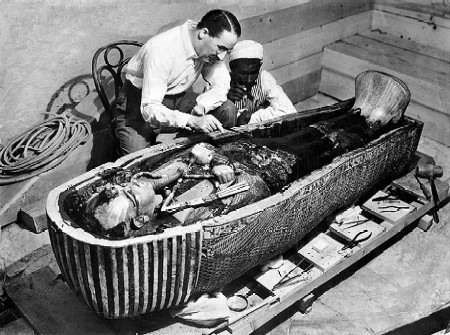
Howard Carter with the Tomb of Tutankhamen, Wikipedia (1925)
its roots in the beginning of the 19th century, growing from the interest generated reports published by a scientific team brought to Egypt by Napoleon. "Publication of the expedition's work, the Description de l'Égypte, began in 1809 and came out in a series though 1826, inspiring everything from sofas with Sphinxes for legs, to tea sets painted with the pyramids." ("Egyptian Revival decorative arts", Wikipedia, gathered 3-31-25) Later discoveries caused similar revivals during the next century, although nothing on the scale of what occurred when Tutankhamun's tomb was discovered in 1922.
Theodore Davis excavated the Valley of Kings between 1905 and 1914, discovered ten tombs and some items referring to Tutankhamun. He believed this to refer to the pharaoh's lost tomb. Howard Carter was invited to excavate in the valley on behalf of George Herbert, 5th Earl of Carnarvon in 1907. Because Theodore Davis had concession rights, Carter spent the next seven years working in the greater area of the Theban Necropolis, outside the valley. In 1914, Davis indicated that he thought he had uncovered all that there was to find in the valley, giving Carter access to the site. Carter began a systematic search of the valley in 1915, discovering the tomb of Tutankhamun in November of 1922. The seal of the tomb was broken in February, 1923.
News of the discovery and images of the finds in the media created a wave of Egyptomania, with the public fascinated by the discovery as Carter and his team
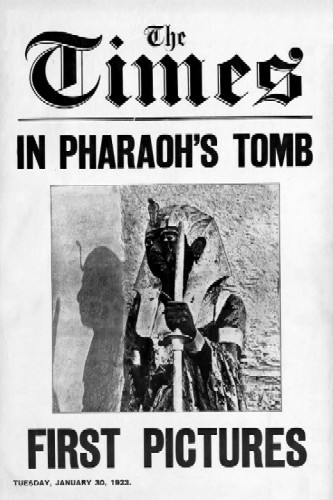
Times Special on Tutankhamen (1923)
explored it over the next ten years. Eager to feed the fascination, news reels, magazines and newspapers ran stories on the finds as the occurred. The New York Times ran the first color images of the finds found in the tomb in America in 1924 with coverage by media outlets continuing into the 1930s.
Art Deco era design reflected several elements of ancient Egyptian design, particularly during the 1920s. Among them:
- The use of decoration, found on a variety of surfaces in Tutankhamun's tomb impacted the decorative interior designs of the 1920s which used patterns and design elements in a variety of places including wallpaper, rugs, upholstery, artwork and furniture.
- Extensive decoration, hieroglyphics and mystical symbols were found in the tomb. These designs were replicated in some Art Deco era interior designs.
- Ancient Egyptian architecture included rather precise geometric forms such as symmetrical pyramids and obelisks. Art Deco similarly emphasized clean lines, strong geometric forms, angular shapes and symmetry.
- Stylized representations of nature appeared in the ancient Egyptian objects found in the Valley of Kings. The 1920s saw a similar stylization of things natural, particularly in art. An excellent example appears in the wall panels created by Jean Dupas and Jean Dunand for the Normandie. (Examples can be found in this post on Facebook.)
- The Egyptians absorbed and incorporated the symbols of the cultures of the people which they had dominated. In a similar manner, the designers during the Art Deco era incorporated the symbolism of the past including elements from other cultures' pasts (such as the use of Egyptian, Grecian and Mayan cultures).
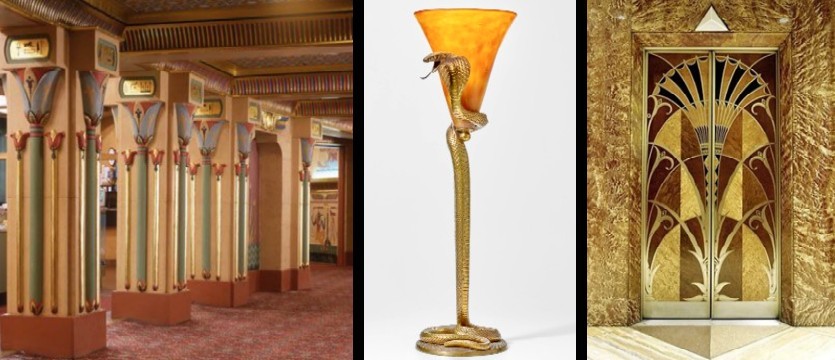
Egyptian Influenced Designs, from left - Ornate Columns with Flowers and Hieroglyphics, Egyptian Theater, Boise, Idaho, 1927. Pinterest; Table Lamp
with Cobra, Gilt Bronze and Glass, Edgar Brandt, c. 1925, Bonhams; Elevator Doors with Blossom, Chrysler Building, 1930, reddit
- Both eras exhibited lavish styles using precious materials such as gold, silver and precious stones. Tutankhaman ruled for about 10 years near the end of the golden era of ancient Egypt which allowed for the use of many exotic materials. Art Deco style was popular during the golden age which followed the end of World War I, encouraging a similar use of exotic materials.
- The most obvious impact of the ancient Egyptian discoveries was the use of elements in Art Deco designs. Symbols such as ankhs, winged suns, lotuses, scarabs, eyes of hours, urns, snakes, papyrus blooms, cats, gods, goddesses and even mummies appeared in furnishings and architecture during the 1920s and early 1930s.
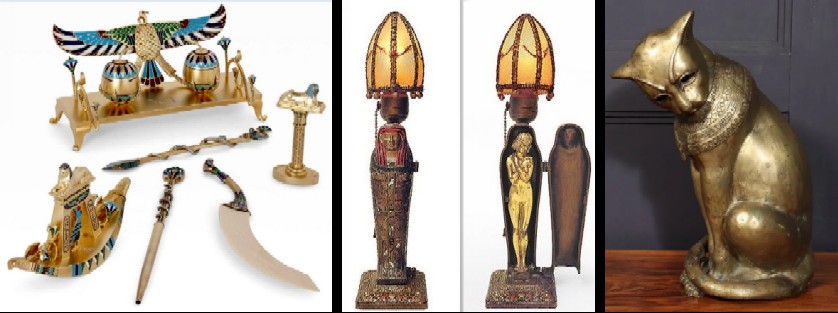
Egyptian Influenced Designs, from left - Desk Set, Enamel and Silver Gilt Egyptian Revival Set, Inkstand on Eagle Pen Rest, Sphinx Desk Seal, Ivorine Blade Letter Opener, Blotter, Pencil and Sharpener, 1920s, Incollect; Mummy Lamp, Cold Painted Spelter, L. V. Aronson Art Metal Works, 1923, Pinterest;
Bastet Cat Statue, Gold Patinated Bronze with Hieroglyph Collar, c. 1930, The Old Cinema
While the impact of the Egyptian discoveries appeared in Art Deco designs during the 1920s, the Streamline Moderne era which followed the stock market crash of 1929 led a decline in their use. The lavish symbols and materials no longer seemed as appropriate during the sobering Depression which followed. Much of the use of Egyptian designs which appeared in the early 1930s was the result of buildings which had been planned and designed before the crash.
Sources Not Mentioned Above:
"Influences of Egyptian Art on Art Deco", UK Essays website, gathered 4/1/25
"Art Deco Origins & Influences", Art Deco Society of New York website, gathered 4/2/25
"Art Deco & 20th-century Architecture", Archeological Institute of America website, gathered 4/2/25
"Egyptian Revival: 1880 - 1930", Washington Department of Archeology + Historic Preservation website, gathered 4/2/25
"Tutankhamun", Wikipedia, gathered 3-31-25
"Egyptomania - The Egyptian Influence on Art Deco" Canonbury Antiques website, gathered 4/2/25
"Egyptomania Explained: The Influence of Ancient Egypt on Western Art", M. S. Rau website, gathered 4-2-25
"Egyptian Art Deco Enchantment", Venice Clay Artists website, gathered 4-2-25
Nicky Hughes,
"How Tutankhamun Influenced 20th Century Design and Architecture", The HIstoric England Blog, gathered 4-2-25
Original Facebook Group Posting
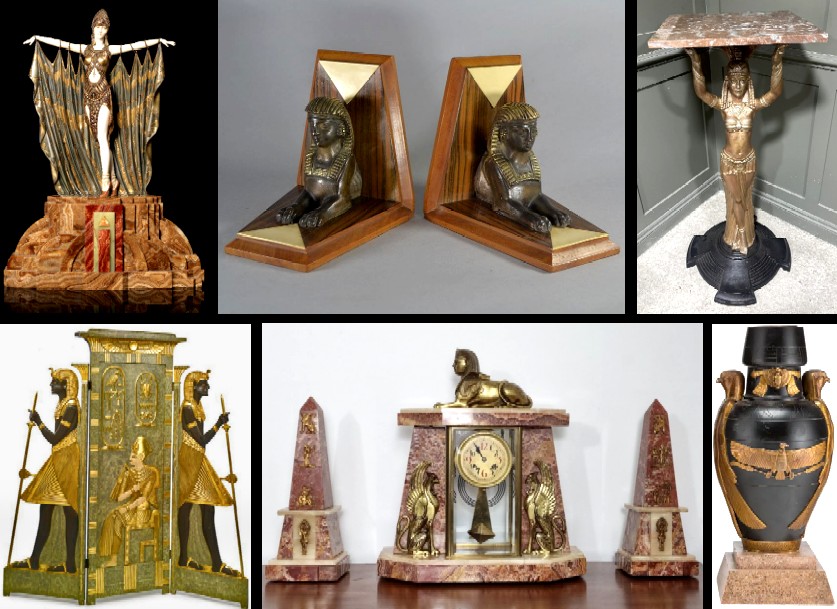
Egyptian Influenced Designs, from top left - 'Semiramis' Statue, Cold Painted Bronze, Demetre Ciparus, c. 1928, Bonhams; Sphynx Bookends, Metal Statue with Wood and Bakelite Base, 1930s, 1930.fr; Table, Cast Iron Statue holding Marble Top, c. 1920s, The Retro Business; Egyptian Revival, Black Slate Urn, Cast Gilt Sun God Horus, Granite Pedestal, 1920s, Chairish; Clock and Obelisks, Bronze, Marble and Onyx, 1920s, Pamono; Screen, Probably Painted Wood, c. 1925, Venice Clay Artists